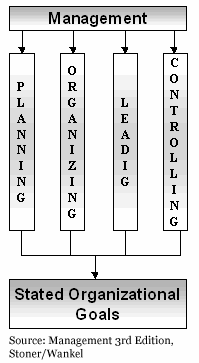What are functions of management
The process of management consists of certain basic management functions. The most commonly cited four basic functions of management are planning, organizing, leading, and controlling.
Four Basic Functions of Management
Planning is the first tool of the four functions in the management process. Planning is the logical thinking through goals and making the decision as to what needs to be accomplished in order to reach the organizations’ objectives. Managers use this process to plan for the future, like a blueprint to foresee problems, decide on the actions to evade difficult issues and to beat the competition. Planning is surely an ongoing step, and can be extremely specialized depending on organizational, division, departmental, and team goals. It is up to the manager to identify which goals have to be planned within his or her individual area.
Organizing means that managers coordinate the human and material resources of the organization. The effectiveness of an organization depends on its ability to marshal its resources to attain its goals. To ensure that objectives set by planning can be achieved, the organizing function takes the tasks identified during planning and assigns them to individuals and groups within the organization. Organizing involves the following:
- Identification of activities.
- Classification of activities.
- Assignment of duties.
- Delegation of authority and creation of responsibility.
- Coordinating authority and responsibility relationships.

Read Also: What does management mean?, Characteristics of Management
Leading describes how managers direct and influence subordinates, getting others to perform essential tasks. Effective leading requires the manager to motivate subordinates, communicate effectively, and effectively use power. If managers are effective leaders, their subordinates will be enthusiastic about exerting effort toward the attainment of organizational objectives. It goes beyond merely handling tasks; rather, it requires communicating, encouraging, inspiring, and motivating workers towards a higher level of productivity.
Controlling makes sure the organization stays on the path that was planned for it. Gemmy Allen stated that ‘Controlling is the final link in the functional chain of management activities and brings the functions of management cycle full circle.’ Controlling consists of three steps, which include establishing performance standards, comparing actual performance against standards, and taking corrective action when necessary. The controlling process usually leads to the identification of situations and problems which must be resolved by creating new performance standards.



